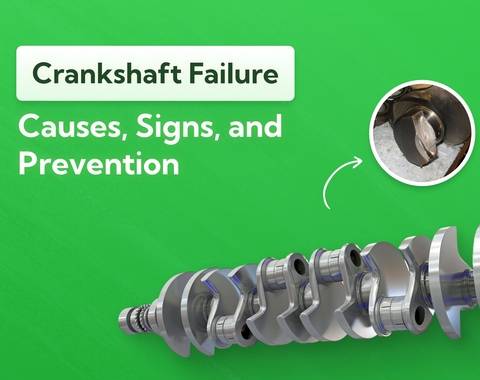Head Gasket Repair & Replacement Cost in the UK [2025]
Blown head gasket? This guide covers 2025 repair costs by car model, common symptoms, how to reduce your bill and when it’s better to just scrap it. From budget cars to high-end engines, we break down what impacts prices across the UK.
Last updated: 16th October, 2025

Anthony Sharkey is COO at New Reg Limited (Car.co.uk, Trader.co.uk, Garage.co.uk), driving innovation in vehicle recycling, logistics, and customer experience.

Listen to this story
The head gasket might be small, but it plays one of the biggest roles in your car’s engine. It seals the space between the engine block and cylinder head, keeping oil and coolant from mixing and maintaining the right compression for combustion.
When a head gasket starts to fail, early signs like white smoke, overheating and milky oil are your cue to take it in ASAP. Left unchecked, a minor leak eventually turns into full engine damage that might cost more to repair than the car’s even worth.
In 2025, you can expect head gasket repair and replacement to cost anywhere from £500 to over £2,000. That all depends on the vehicle, labour rates and extent of engine damage. Luxury and performance models sit at the higher end, while smaller cars are cheaper to fix.
In today’s article, I’ll walk you through all the technicalities and what to expect.
What's in this article
- 1. How does a head gasket work?
- 2. Head gasket repair vs replacement costs (cost breakdown)
- 3. Head gasket cost by car make and model
How does a head gasket work?
The head gasket sits between the engine block and the cylinder head, forming a tight seal that keeps three critical systems separated: the combustion chambers, the coolant passages and the oil channels.
Its main job is to contain the high-pressure explosion happening inside each cylinder. At the same time, it keeps engine oil and coolant flowing through their respective channels without mixing, all while withstanding extreme heat and pressure.
That balance is essential for your engine to run efficiently and stay cool under stress. If the head gasket fails, those systems leak into one another. Coolant seeps into the combustion chamber. Oil mixes with coolant. Compression drops.
Left untreated, those issues lead to overheating, poor performance and in serious instances, catastrophic damage to your engine.
Head gasket repair vs replacement costs (cost breakdown)
Repairing a small head gasket leak is only a fraction of the cost of a head gasket replacement. But it’s only a viable option if you’re dealing with a small leak. And even then, it’s a temporary fix, not a permanent one.
Repair costs
If you have a tiny leak in your head gasket, you can temporarily patch it up with head gasket sealer. Most sealers cost between £20 and £60 per bottle and you’ll need 1 to 3 bottles depending on whether you have a 4, 6 or 8-cylinder engine.
There’s no labour involved; you can do it yourself at home.
- Drain or lower coolant to keep sealer from diluting too much.
- Shake the bottle well and add the sealer to the radiator or expansion tank.
- Top up with water or the specified coolant mix. Cap it.
- Start the engine and set the heater to max hot.
- Idle, then hold 1,500 to 2,000 rpm so the thermostat opens and flow carries sealer to the leak.
- The sealer follows coolant into the breach. Heat plus pressure helps it bond and harden at the leak point.
- Let the engine cool completely.
But again, this is only a temporary fix. It lasts for a few weeks to a few months at most (less if you drive the car every day). If your head gasket is damaged or blown, you will definitely need to replace it, no matter what.
Replacement costs
In 2025, a full head gasket replacement in the UK typically costs between £500 and £2,000. The wide range comes down to one key factor: labour.
Replacing a head gasket isn’t a simple job. It involves stripping down large parts of the engine just to access the gasket, which can take anywhere from 6 to 12+ hours depending on the vehicle. The part itself only costs £50 to £150, but labour easily runs into the hundreds.
The make and model of your car makes a big difference too. A small petrol engine like a Ford Fiesta costs far less to repair than the complex turbocharged engine in a BMW or Land Rover. And you need to factor in extra services that come with a full replacement (like head skimming, pressure testing and replacing the timing belt if it’s due).
Here’s a rough breakdown of where your money goes:
| Cost component | Typical price range | Notes |
|---|---|---|
| Labour | £500 to £1,200 | Major portion of cost. Engine disassembly is time-intensive. |
| Head gasket part | £50 to £150 | Varies by vehicle make, engine size and brand. |
| Head skimming / pressure testing | £60 to £150 | Resurfaces the cylinder head to ensure a proper seal. |
| Timing belt (if due) | £300 to £1,000+ | Often replaced during the job to save on future labour. |
| Coolant & oil refill | £30 to £80 | Necessary after disassembly and flushing. |
| Gasket set / sealant extras | £40 to £100 | Includes other seals removed during the job. |
| Total estimate | £500 to £2,000+ | Final price depends on engine type and garage rates. |
What the experts say

Steven Jackson OBE
A professional garage will give a full quote that includes all of the above. Make sure you get it up front so you’re not blindsided later or overcharged.
Head gasket cost by car make and model
Smaller, simpler engines are quicker to work on. That means lower labour costs and fewer complications. Larger, high-performance and tightly packed engines all mean more time in the workshop, more disassembly, specialised service and higher-cost parts that need replacement or recalibration along the way.
In general:
- Budget cars (like a Ford Fiesta or Toyota Yaris) are the cheapest to fix.
- Mid-range models (like a VW Golf or Honda Civic) fall somewhere in the middle.
- Luxury or complex cars (like a BMW 5 Series, Subaru Outback or Audi A6) top the charts due to difficult engine layouts or premium parts.
We’ll break down typical costs by category in the next few sections. But as a rule of thumb, if the engine bay is tight, the engine is turbocharged, or the car was built for performance, expect to pay more.
Budget and small cars
For compact hatchbacks and small petrol engines with less complexity, you can reasonably expect a head gasket replacement to fall somewhere in the £500 to £1,200 band, assuming no extreme damage or complications.
Lower engine complexity also means fewer knock-on costs. For instance, you won’t need turbo-related parts or complicated engine management recalibrations.
Mid-range cars
For mid-range vehicles, head gasket replacement usually falls between £900 and £1,400. This includes models like the Volkswagen Golf, Honda Civic, Ford Focus, Mazda 3 and Skoda Octavia.
These cars have more powerful engines than budget models (including some turbocharged options) and tighter engine bays. That increases labour time and, sometimes, the number of components that need to be removed and refitted during the repair.
Brand reputation also plays a part. Popular models with widely available parts cost less, while those with specialised or imported components drive the price up. For instance, a head gasket job on a Honda Civic is usually more affordable than on a less common model from a premium-leaning brand like Volvo or Peugeot.
If the engine is a larger four-cylinder or low-end six-cylinder, expect to pay more than you would for a basic 1.2L engine, but not as much as for high-end or performance models.
Premium and luxury cars
For premium and luxury vehicles, head gasket replacement can cost anywhere from £1,000 to over £2,500, depending on the make, engine layout and whether the job requires major engine removal.
Models in this category include the BMW 3 and 5 Series, Audi A4/A6, Mercedes-Benz C-Class, Land Rover Discovery and high-spec Subarus like the Outback and Forester. These cars come with high-performance engines (like turbocharged or V6/V8 configurations) which are far more complicated to disassemble and reassemble correctly.
You’re also dealing with tighter tolerances, more electronic systems and sometimes specialised tools or procedures only certain garages are qualified to handle.
4-cylinder vs 6-cylinder engines
4-cylinder engines are the most common in UK cars and are the cheapest to repair. They’re compact, easier to access and require less labour to dismantle. In most cases, a head gasket replacement on a 4-cylinder engine will fall between £500 and £1,200.
6-cylinder engines are far more complex. Because the cylinders are split into two banks, mechanics need to remove more components and possibly even lift the engine out entirely. Labour time increases significantly and in lots cases, both cylinder heads need to be skimmed and resealed. That puts the typical cost closer to £1,400 to £2,000+.
V8 engines raise the stakes further, not just in terms of size and layout but also in specialist knowledge required to work on them. High-end specialist garages will work on these cars at a premium price.
Factors affecting head gasket repair and replacement costs
Head gasket jobs vary widely in price, and it’s not just about the part itself. There are six factors that drive the cost up or down:
- Car make and model: Some engines are much harder to work on than others.
- Severity of damage: The longer it’s left, the more costly the repair.
- Labour costs: Rates vary by location and type of garage.
- Replacement parts: OEM parts are more expensive.
- Extra repairs: Timing belts, skimming and cracked heads add to the bill.
Let’s take a look at each of these in more detail.
Car make and model
Your car’s brand and model have a big impact on what a head gasket repair will cost. Some engines are simple to access and fix. Others are cramped, complex or built with expensive components.
Our Garage expert reports that head gasket replacement on a Ford Fiesta ranges from £500 to £1,120, depending on the engine type and whether you use a main dealer or independent garage. In contrast, a BMW 3 Series of the same age can cost anywhere from £555 to £2,342.
Severity of damage
A minor head gasket leak will only require resealing, cleaning and replacing a few related components in most cases. That keeps the bill closer to the lower end of the range.
But a catastrophic failure can lead to coolant and oil mixing, warped cylinder heads and even a cracked engine block. At that point, the job involves head skimming, pressure testing and possibly a full engine rebuild, which costs well over £2,000.
Labour costs and time
Garages in London and major cities charge more per hour than those in smaller towns or rural areas because the cost of doing business is a lot higher. Independent mechanics are cheaper than main dealers, but the difference in experience and equipment matter for complex jobs. If you have a higher-end car, you might have no choice but to go with a specialist mechanic.
The quickest head gasket replacement jobs take 6 to 7 hours. Mid-range ones will take 8 to 12 and intricate ones will require more than 12 hours. The more time it takes to strip down and rebuild, the more you’ll pay.
Parts and materials
OEM (original equipment manufacturer) parts are made by the car’s brand or approved suppliers. They’re more expensive but come with guaranteed fit and reliability. Aftermarket parts are cheaper and widely available, but quality can vary depending on the brand.
Beyond the head gasket itself, a full repair often includes several extra components, which add to the final price:
- Seal kits and gaskets (£40 to £100): Required to reseal other parts removed during the job.
- Coolant (£10 to £30): Drained during repair and needs replacing.
- Engine oil and filter (£15 to 40): Also replaced after the job.
- Timing belt and water pump (£300 and £1,000+): Often replaced at the same time if they’re due, since labour overlaps.
- Sealants and adhesives (£5 to £50): Used to ensure a proper seal during reassembly.
Additional repairs needed
During the repair, don’t be surprised if the mechanic finds related damage or worn components that also need attention.
- Head skimming (if the cylinder head is warped from overheating)
- Timing belt replacement (since the timing belt usually has to be removed anyway)
- Water pump or thermostat (if they show signs of wear or are buried under the same labour)
These add a few hundred to the final cost. But they do also prevent future breakdowns and double labour charges. So it’s usually a good idea to go for it if the mechanic suggests it.
Additional costs beyond parts and installation
Depending on the condition of your engine, how long the problem has been left unresolved and your car’s maintenance history, you might face extra costs that aren’t part of a basic quote. These include:
- Machine work (like head skimming or pressure testing)
- Fluid replacements (coolant, oil, etc.)
- Diagnostic work to confirm the issue before repairs begin
- Post-repair testing to make sure there are no ongoing issues
- Costs from extended damage like cracked heads, blocked coolant passages or failed sensors
In the next few subsections, I’ll break down the hidden costs so you know what to expect.
Labour complexity
If the head gasket is buried under layers of components or requires special tooling, it’s going to be more difficult to work on.
Here are common factors that increase labour complexity:
- Tight engine bays (common in BMWs, Audis, and Minis)
- Transverse engine layouts that limit access from above
- Turbochargers and intercoolers that must be removed and refitted
- V6 or V8 engines with multiple cylinder heads
- Timing chains instead of belts (more time-consuming to realign)
- Front-wheel drive setups with limited engine clearance
- Engines that need to be partially or fully removed to reach the gasket
Total impact to final cost: 200 to £800+
Cylinder head skimming
Se cylinder head to make it perfectly flat again. It’s a common add-on in skimming is the process of machining the head gasket jobs when overheating has caused the cylinder head to warp. Some garages include skimming in their quote, but many treat it as a separate service.
Total impact to final cost: £60 to £150
Additional parts and materials
The mechanic will also replace multiple supporting parts and consumables during the job to make certain everything will run properly afterward.
These include:
- Seal kits and gaskets
- Coolant (antifreeze)
- Engine oil and filter
- Sealants and adhesives
- New head bolts (if stretch bolts are used)
Like I mentioned earlier, you’ll also get to choose between OEM and aftermarket parts. OEM parts cost more but guarantee compatibility and quality. Aftermarket options are cheaper but can vary in reliability, which is why we always advise against them.
Total impact to final cost: £50 to £250
Timing belt and chain replacement
If your car’s timing belt (or timing chain) needs to come off to access the head gasket, which it often does, most mechanics will recommend you replace it while the engine is already stripped down.
The reason is that these are wear-and-tear items. They’re usually due for replacement every 60,000 to 100,000 miles. If yours is nearing the end of its service life, doing it during the gasket job saves money on future labour.
Total impact to final cost: £300 to £1,000+
Specialised tools and equipment
Some head gasket jobs require manufacturer-specific tools or advanced equipment to do the job properly. This is especially true for high-end or performance engines.
For example:
- BMW and Audi engines may need camshaft locking tools or timing alignment kits.
- Subaru boxer engines often require engine cradles or jigs to lift the entire unit.
- Modern engines may need diagnostic equipment to reset ECU parameters after repair.
- Torque-to-yield bolts require precise torque angle gauges to avoid engine damage.
Garages that invest in these kinds of things charge a premium because they know not every local mechanic will have the right tools on hand.
Total impact to final cost: £50 to £200
Signs of a blown or failed head gasket
Head gasket failure often starts with small warning signs, but ignoring them can quickly turn a minor repair into a full engine rebuild.
There are five common symptoms:
- Engine overheating
- White smoke from the exhaust
- Milky or creamy-looking oil
- Loss of coolant with no obvious leak
- Poor engine performance or misfiring
These signs mean the gasket is no longer sealing the engine properly. If you ignore them, it’ll lead to warped cylinder heads, cracked engine blocks and catastrophic engine failure — all of which layer on the extra repair costs we’ve just detailed above.
Overheating engine
When the gasket no longer seals the combustion chamber properly, hot gases leak into the cooling system or coolant leaks out. Either way, the engine runs hotter than it should because it can’t properly regulate the temperature.
Aluminium cylinder heads (common in most modern cars) are particularly vulnerable. If the engine overheats even once and the temperature spikes into the red for several minutes, it’ll start to warp. To prevent severe damage, you have to address overheating issues immediately.
White smoke from the exhaust
Thick white smoke from the tailpipe usually means coolant is entering the combustion chamber and being burned alongside fuel. If the smoke appears on cold starts and smells slightly sweet, it’s time to get the engine checked.
A healthy engine keeps coolant completely separate from the combustion chambers. When the head gasket fails, it can allow coolant to leak into the cylinders, where it mixes with air and fuel and gets burned during combustion.
Milky or foamy oil
If your oil looks milky, beige, or like a frothy coffee, it’s probably contaminated with coolant. This happens when a failed gasket allows coolant and oil to mix. Contamination reduces the oil’s lubricating abilities and wrecks your engine from the inside out.
Loss of coolant
If your coolant level keeps dropping but there’s no visible leak under the car, it could be leaking internally through the head gasket. The gasket’s job is to seal the engine’s internal passages and when it fails, coolant can leak into areas it shouldn’t.
It’s serious because coolant loss can lead to overheating, oil contamination, and severe engine damage. This type of leak is harder to spot, so drivers normally miss it until the engine starts to overheat or show other symptoms.
Coolant is supposed to last for 30,000 to 60,000 miles. If you just changed it six months ago and you haven’t driven the car excessively but the levels are extremely low, get that checked out.
Engine misfire or rough idle
A damaged head gasket can lower cylinder compression, which results in poor throttle response, rough idling and misfires. This tanks your engine performance. So if your car feels sluggish, vibrates at idle or struggles to accelerate, a head gasket issue is probably to blame.
How to Reduce Head Gasket Repair Costs
Now… head gasket repairs aren’t ‘cheap’ by any means. But there are ways to keep the cost under control. From choosing the right mechanic to being smart about parts and labour, a few key decisions can make a big difference.
In this section, we’ll cover practical strategies to lower your bill:
- Getting multiple quotes
- Choosing a trusted independent garage
- Using quality aftermarket parts
- Considering a DIY approach (if you’re confident)
Get multiple quotes
Always get at least three quotes from a mix of:
- Franchise dealerships
- Independent mechanics
- Mobile mechanics (where available)
This gives you a better sense of the going rate and helps you spot any garages overcharging or pushing unnecessary extras. You'd be shocked, but in my experience, repairs sometimes vary by £300 or more for the exact same job.
Make sure each quote lists what’s included (labour, parts, skimming, fluids) so you’re comparing like for like.
Consider independent mechanics vs dealerships
While dealerships have brand-specific expertise and quick access to OEM parts, the main drawback is cost. Labour rates at dealerships are typically much higher because of their overheads. Larger facilities, brand requirements, deeper expertise and higher technician wages all factor into the final bill.
Independent mechanics generally offer:
- Lower hourly rates
- Faster turnaround times due to less red tape
- More flexibility with aftermarket or reconditioned parts
- A more personalised service, especially at trusted local garages
If your car’s not out of warranty yet, getting work done at an independent garage might void it (double-check this beforehand). But if that’s not a concern, choosing a reputable independent garage will save you hundreds of pounds without sacrificing quality.
Use aftermarket parts
Opting for aftermarket parts instead of OEM components is a simple way to cut down the cost of a head gasket repair. Aftermarket head gaskets, seal kits, and timing belts are often 20-50% cheaper, and plenty come from reputable brands with solid track records.
That said, cheaper options sometimes lack the precision or durability of OEM parts, especially on high-performance engines or vehicles with tight tolerances.
If you go this route:
- Stick to known brands with strong reviews.
- Ask your mechanic for recommendations based on your specific car.
- Consider OEM for critical parts, and aftermarket for supporting components like seals and hoses.
DIY head gasket repair
If you have the right tools, skills and mechanical experience, doing the repair yourself saves you 90% of the head gasket repair and replacement cost. This is most feasible on older cars with simple 4-cylinder engines, where access to the gasket is straightforward.
But it’s not for beginners. The job requires precision torque settings, careful timing alignment, clean sealing surfaces and the ability to spot related issues (like warped heads or worn bolts). If you’re not an experienced mechanic yourself, a mistake will only make things worse.
Regular car maintenance
The best way to reduce head gasket costs? Prevent yourself from needing the repair in the first place. Checking coolant levels regularly, use the right coolant mixture, address cooling system issues early, avoid prolonged overheating and keep to your service schedule. Do that and you’ll save thousands on future repair costs, well beyond the head gasket replacement.
Modern cars vs traditional cars: head gasket differences
Replacing a head gasket on a modern car is a completely different beast than it was 20 years ago.
Older cars, like a ‘90s Fiesta or Corolla, had simple engines, plenty of room to work and gaskets made from basic composite or copper. You could get in, swap it out and be done without dismantling half the engine.
Now? You've got turbochargers, timing chains, direct injection, emissions systems, and sensor-packed everything. The engines are engineered to be efficient and powerful, but they’re more intricate and therefore harder to work around.
And the gaskets themselves are made of multi-layer steel (MLS). Great for sealing high-pressure, high-heat combustion chambers. But they require precision machining, spotless surfaces and perfect torque to seal properly.
This all adds up to more hours, more labour and a higher chance of "while we're in there" repairs stacking up.
When to repair, replace or scrap your car?
A blown head gasket puts you at a crossroads. Do you fork out for the replacement or cut your losses and scrap the car? The right move depends on your car’s value, age, mileage and how much life it’s realistically got left.
When to repair the head gasket?
Once the gasket’s failed, there’s no patching it up or sealing it long-term. It’s a precision part that’s been crushed into place between the engine block and cylinder head. When that seal breaks from overheating, age or pressure, it’s game over for that gasket.
There are sealers out there that claim to “fix” head gasket leaks. At best, they’re temporary stopgaps to squeeze out a few extra miles. But even then, they’re not capable of stopping anything beyond small leaks (e.g. between the coolant passage and the combustion chamber).
When is replacement the best option?
If it’s more than a tiny leak and you’re seeing white smoke, overheating or coolant in your oil, you’re past the point of quick fixes. Replacement becomes the only real option.
But is it worth it?
Replacing the head gasket makes sense when these four conditions are met:
- The car’s in good overall condition.
- The total repair cost is less than 50% of the car’s value.
- The engine hasn’t suffered serious internal damage.
- You plan to keep the car for a while after the repair.
Weigh the costs versus the benefits. If your car’s worth £4,000, the repair costs £1,200 and you want to keep the car, it’s worth doing. But if the car’s worth £1,500 and the job costs that same £1,200? You’re throwing money away.
When to scrap your car?
Scrapping makes more sense when the repair cost outweighs the car’s value or usefulness. If the head gasket job is quoted at £1,200 but your car’s only worth £1,000 running, you’re better off walking away.
Also consider scrapping if:
- The car has 100,000+ miles and other issues brewing (rust, worn suspension, slipping clutch).
- It’s older than 10 to 15 years and not ULEZ-compliant or fuel-efficient.
- You’ll have to sink money into other major repairs as well.
- You’re not planning to keep the car long-term.
The sad truth? Some cars just aren’t worth saving. If the engine’s cooked, the MOT’s nearly up and it’s due for new tyres and brakes, scrapping it now might actually save you from death-by-a-thousand-repair-bills.
Good news is, the process is easy. To get started:
- Get an instant scrap car quote from us in 30 seconds.
- Choose your free collection time (we come to you).
- Hand over the keys and logbook (V5C).
- Get paid via bank transfer at the pickup point.
- We notify the DVLA so you’re fully cleared.
About Car.co.uk

Share on
Latest news & blogs










